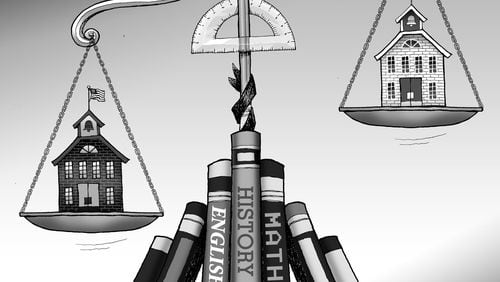I have been watching the progress of Clayton County Public Schools with great interest over the last few years. I was on the AJC editorial board when Clayton was at its worst, in large part because of a self-serving school board and a revolving door of school leaders. Some Clayton members told the AJC they needed “their jobs” with the school board to pay their bills.
In 2008, I wrote: “There’s little to cheer about right now in Clayton, where a meddling school board has put the entire school system’s accreditation and the future of its students at risk for the second time in five years…If there’s a glimmer of hope left in Clayton, it will take the Hubble Space Telescope to find it.”
That hope is much more visible today. My MyAJC.com reports today Clayton saw its three schools eligible for possible state takeover due to under performance improve their standing enough to escape the list.
Nearly half the takeover-eligible schools are in metro Atlanta. DeKalb County has the most schools eligible for takeover, 28; Atlanta has 22, including some schools that have closed or will be merged or closed next year. Ten schools are in Fulton County. Three others are state-approved charter schools, including two in metro Atlanta and one online school. Voters will decide in November whether to approve Gov. Nathan Deal's Opportunity School District, which can seize control of failing schools.
AJC education reporter Marlon Walker reports on MyAJC.com Clayton has no schools on the list now, which district leaders credit to curriculum changes and a focus on individual student needs. It was the only district to see all its schools removed.
Walker reports:
"The biggest difference was the assistance coming from the district with content-specific coaches assisting teachers with the lesson models, and the monitoring we did as an administrative team here," said Townsend, who has been the school's principal since it opened in 2009. "You go in and you want to make sure good teaching is happening. We looked at the classrooms and the framework we were using and made sure … it was working."
He said attention to student testing data was important in the turnaround. The data showed math was a problem for many of the students coming into the school. In addition to freshman algebra, the students also take an algebra support class, which has resulted in major improvement in the school's math scores. If a student is struggling, that student may be moved to a different class to see if he or she has a better outcome.
I've been exchanging emails with education writer Myra Blackmon on the issue of Atlanta Public Schools vs. Clayton Schools. Both districts teach many poor students. Both overcame messy pasts. Why does Atlanta Public Schools seem to struggle more with school turnaround than Clayton?
A columnist for the Athens Banner-Herald, Blackmon holds a master's of education degree from the University of Georgia. She was intrigued and looked closer at the two neighboring districts. She writes:
I speculated that perhaps because elementary schools generally have the smallest attendance zones, they may intensify poverty levels in some schools. Indeed, some claim that school districts often intentionally draw zones to segregate affluent and poor children. Given the proven link between poverty and low academic performance that just might be the case.
The observation, however, raises the question of why Clayton County Public Schools, right next door and with similar enrollment and poverty levels, has no elementary schools on the state takeover target list, although three of its high schools appear on the list.
When I dug into the statistics that might explain this discrepancy, I was surprised at what I found. In both districts, enrollment in Pre-K is about 23 percent of kindergarten enrollment. That belies the claim that we have achieved universal Pre-K. Enrollment numbers in grades K-5 are almost identical in the two districts.
With some 53, 400 students, Clayton annually spends $7790 per student, with $4984 of that devoted to instruction. APS with three thousand fewer students spends $14,213 per student, with $8941 of that for instruction.
Using the free-and-reduced-lunch measure, Clayton is much poorer than APS, with 95 percent of students eligible in 2015 versus APS' 76 percent in 2016. (It appears that in 2016 Clayton County is taking advantage of a program that provides 100 percent of students with free lunch.)
The discrepancy can't be easily explained by pre-K, instructional or support expenditures, or poverty. So I looked at the 2014 CCPRI numbers for each district. Again, the scores are very close. APS has an overall score of 62.6 (out of a possible 100 points) while Clayton shows an overall score of 63.4. Clayton's elementary CCPRI is about 10 percent lower than APS, with a 31.32 compared to a 34.35.
Both districts have been through trauma and upheaval in the last few years. Clayton almost lost its accreditation and its school board was taken over by the state. APS had to deal with its test cheating scandal. Both seem to have stabilized and put their crises behind them.
There is no readily apparent explanation for the high number of APS schools on the state target list. This phenomenon should raise questions about the construction and validity of the CCPRI for all schools in the state.
A few days later, Blackmon followed up with an email on something we've debated here on the blog: Does the depth of poverty or how far back it stretches in a family tree affect student performance? Does multi-generational poverty cast a shadow that is hard for children to ever escape?
I've met successful immigrant students in high poverty schools who had one influential edge over their American-born peers: their parents were educated in their home countries, and they had a family history of literacy. Their parents made sure they went to school and studied at home.
Blackmon had lunch with a former superintendent and ran the Clayton vs. APS question by her. The educator told her, “that although free and reduced lunch rates and other indicators of poverty may be similar, the kind of poverty in APS is different: multi-generational, more children living in ‘no income households’ as opposed to Clayton where there may be more people working low-wage jobs, children in families that are poor but not the poorest of the poor.”
What do you think?
About the Author







